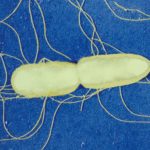Link to Pubmed [PMID] – 27657909
PLoS Negl Trop Dis 2016 Sep;10(9):e0004781
BACKGROUND: The burden of typhoid in sub-Saharan African (SSA) countries has been difficult to estimate, in part, due to suboptimal laboratory diagnostics. However, surveillance blood cultures at two sites in Nigeria have identified typhoid associated with Salmonella enterica serovar Typhi (S. Typhi) as an important cause of bacteremia in children.
METHODS: A total of 128 S. Typhi isolates from these studies in Nigeria were whole-genome sequenced, and the resulting data was used to place these Nigerian isolates into a worldwide context based on their phylogeny and carriage of molecular determinants of antibiotic resistance.
RESULTS: Several distinct S. Typhi genotypes were identified in Nigeria that were related to other clusters of S. Typhi isolates from north, west and central regions of Africa. The rapidly expanding S. Typhi clade 4.3.1 (H58) previously associated with multiple antimicrobial resistances in Asia and in east, central and southern Africa, was not detected in this study. However, antimicrobial resistance was common amongst the Nigerian isolates and was associated with several plasmids, including the IncHI1 plasmid commonly associated with S. Typhi.
CONCLUSIONS: These data indicate that typhoid in Nigeria was established through multiple independent introductions into the country, with evidence of regional spread. MDR typhoid appears to be evolving independently of the haplotype H58 found in other typhoid endemic countries. This study highlights an urgent need for routine surveillance to monitor the epidemiology of typhoid and evolution of antimicrobial resistance within the bacterial population as a means to facilitate public health interventions to reduce the substantial morbidity and mortality of typhoid.


